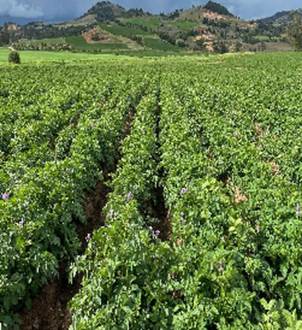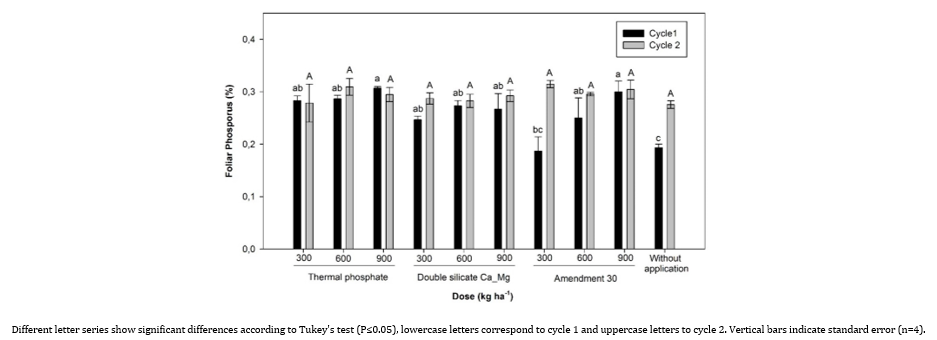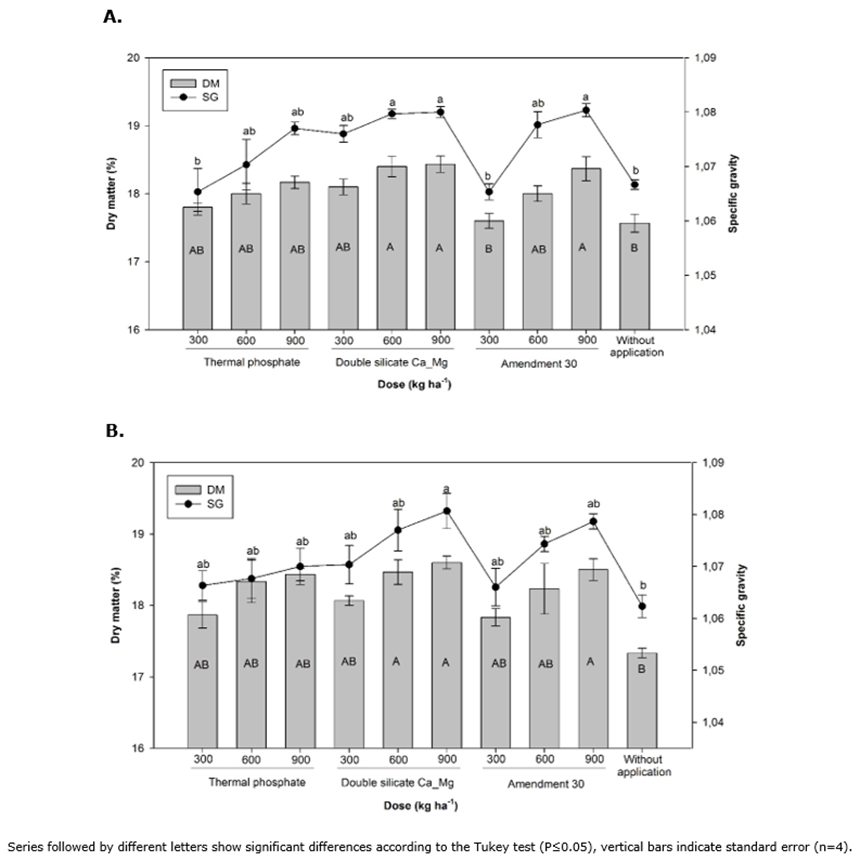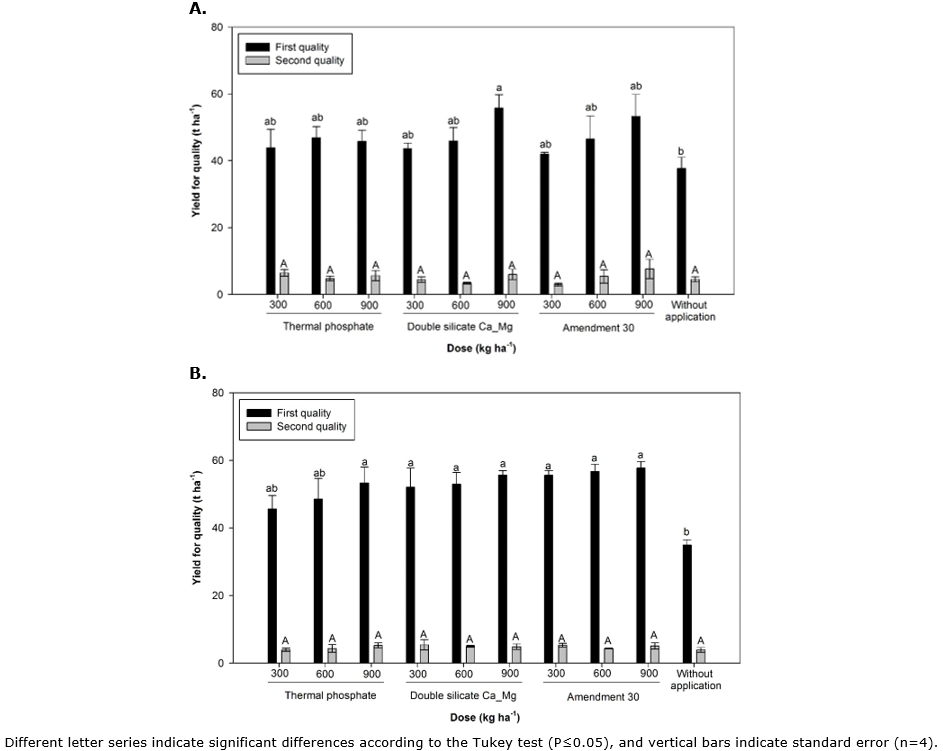INTRODUCTION
The potato (Solanum tuberosum L.) is one of the crops of greatest economic importance and large-scale agricultural production in the world (Zaheer & Akhtar, 2016). It plays a fundamental role in food security due to its yield potential and nutritional value, as it has a high starch content and low fat content (Islam et al., 2022). Additionally, it is a good source of energy, with vitamins including vitamin B6, niacin, folic acid, vitamin C, and minerals such as potassium, iron, phosphorus, and magnesium (Beals, 2019; Mishra et al., 2020). It is a crop of high commercial interest due to its yield potential and various uses (Andre et al., 2014), as it is not only a good source of food but also has a wide range of possibilities for agro-industrial utilization (Jagatee et al., 2015).
One of the most frequent uses of potatoes is their processing into French fries, which is why the quality of the tuber is essential; the quality of potato varieties is assessed through parameters such as total solids, specific gravity, oil absorption, crispness, color after frying, and microbial analysis (Wayumba et al., 2019). Producers need to combine high yields with excellent quality (Camargos et al., 2022). Production and quality in potato cultivation could be related to soil, climate, and cultivation technologies that affect external and internal aspects of the tuber (Abebe et al., 2013; Ngobese et al., 2017; Mishra et al., 2020).
One of the most important factors in production and quality is the adequate supply of both essential and beneficial mineral nutrients, as crop growth and yield depend on the genetic potential of the variety and the fertility status of the soil (Kumar et al., 2015). The yield and quality components of potatoes are directly related to proper management of macro- and micronutrient nutrition (Koch et al., 2020; Naumann et al., 2020).
The availability of nutrients in the soil starts with the proper management of soil acidity, which can be improved with the application of complex amendments, which are a mixture of various lime materials that correct surface and deep acidity, allowing the mixing and contribution of elements such as phosphorus, calcium, magnesium, sulfur, and silicon (Bernal et al., 2016). Therefore, it is very important to gain new knowledge about some of the factors that influence quality and production (Brazinskiene et al., 2014).
The addition of macronutrients such as N, P, K, Ca, and Mg frequently occurs to maintain each of these nutrients in the soil solution and thus supply the plant's needs, as the presence and availability of nutrients at appropriate levels are essential for plant growth and production (Cole et al., 2016). This can be carried out through the application of conventional fertilizers or unconventional sources, including ferti-amendments, which are considered liming materials that provide phosphorus, calcium, magnesium, and silicon. They possess intermediate solubility and citrosolubility, which improve nutrient availability in the short and long term during the entire phenological cycle (Torres-Hernandez et al., 2020) and allow for proper assimilation of nutrients provided through fertilization plans, as they have both amendment and fertilizer effects for acidic soils with low base content (Taubert et al., 2009).
Since adequate nutrient availability is crucial for producers to achieve high crop productivity and proper tuber quality that meets consumer needs, it was proposed to evaluate the dynamics of P, Ca, Mg, and Si accumulation in leaf tissue through the application of increasing doses of three silicate fertilizers and their influence on the quality and yield of 'Diacol Capiro' potato tubers under conditions in the municipality of Soracá, Boyacá-Colombia.
MATERIAL AND METHODS
Location. The research was carried out in the tropical zone of the municipality of Soracá, Boyacá, Colombia, on the Guayacán farm, with geographic coordinates of Latitude: N 5°31'17.6", Longitude: W 73°19'44.2", located at an altitude of 2809 m above sea level (m asl), with an average temperature of 13.2°C and average annual precipitation of 810mm. As the study site, soil with acidity problems, high concentrations of exchangeable aluminum, and low availability of exchangeable bases was selected.
Plant material. The variety 'Diacol Capiro' (Figure 1), also known as "R-12", was used as plant material. It has a moderate plant size, dark green foliage, medium flowering, and low fruit formation. It is highly adaptable (between 1800 and 3200 masl) and is considered a relatively late variety (165 days at 2600 masl). It is the main variety for industrial processing in Colombia, both for flakes and sticks, due to its light cream-colored flesh and good response to frying (Ñústez, 2011).

Figure 1 Experimental potatoes crop variety “Diacol Capiro” in tropical conditions of Soracá, Boyacá, Colombia.
Experimental design. Two evaluation cycles were carried out, each using a Completely Randomized Design, with ten treatments composed of different silicate amendments: a thermal phosphate called T-Fos® (P2O5 20%, CaO 28%, MgO 8.5%, SiO2 15%), produced through the thermal process at 1600°C and subsequent thermal shock with water, which generates highly reactive hydroxide nutrients; a double calcium and magnesium silicate called SiliCalMag® (P2O5 3%, CaO 30%, MgO 13%, SiO2 20%), obtained from the crushing, grinding, and sieving of rocks called serpentines mixed with white slag; and a mixture of 30% calcium carbonate, 30% magnesium silicate, 30% calcium sulfate, and 10% rock phosphate called Triple Amendment 30® (P2O5 3%, CaO 26%, MgO 12%, S 5%, SiO2 12%); applying increasing doses of each silicate amendment following the methodology used by Pinzón-Sandoval et al. (2017)) and Torres-Hernandez et al. (2020)) and a control treatment without application. Each treatment had four replications, for a total of 40 experimental units (EU), each composed of linear furrows of 15 meters with a plant spacing of 0.3 meters, for a total of 50 plants per EU.
The nutritional plan was adjusted according to the soil analysis and the crop requirements described by Guerrero-Riascos (1995), adjusting the nutritional requirements in terms of N, P, and K with simple fertilizer sources such as Urea, DAP, KCl, and minor elements with the application of B-Zn (8% boron + 4% zinc). Pest and disease management was carried out according to monitoring, using protective and systemic products. The most limiting disease was Phytophthora infestans, which was managed with the application of chlorothalonil, dimethomorph, mancozeb, cymoxanil, and metalaxyl. The most limiting pest insect was Tecia solanivora, which was managed with the application of Thiamethoxam, Cyantraniliprole, and Imidacloprid. The water requirement was adjusted to the allowed depletion percentage by phenological stage for potatoes following the methodology used by Guerrero-Guio et al. (2019) , and irrigation was supplied through a sprinkler system.
Variables evaluated. For vegetation quantification, samples of 100 g of dry leaf weight were taken for each experimental unit, following technical indications provided by the laboratories. The content of P, Ca, and Mg in tissue was collected at the Soil and Water Laboratory of the Pedagogical and Technological University of Colombia. The methods used were calcination at 600°C, acid digestion, and valuation by visible spectrophotometry. In addition, a closed wet digestion in a microwave oven with valuation by the atomic absorption-technique of flame was used.
The quality variables of the tuber were evaluated as dry matter percentage (DM) and specific gravity (SG). DM was determined following the methodology described by Haque et al. (2018). For this, five whole tubers per experimental unit were randomly selected for each treatment. The fresh weight was measured, and then the tubers were sliced into small slices (1-2 mm). The dry weight of the samples was determined by drying at 70°C for 72 hours in a forced-air drying oven. The following Equation 1 was used to determine the dry matter content:
The determination of specific gravity (SG) was carried out for five individual tubers (45-55 mm in radius) per EU, following the methodology described by Elfaki & Abbsher (2010). The determination was made based on the weight of a tuber both in the air and completely submerged in a container with water. The specific gravity (SG) was calculated using the following Equation 2:
For performance evaluation, the total tubers were collected for each experimental unit. They were placed in white fiber packages with a capacity of 50 kg and commercially classified into two categories: first and second; where according to the Colombian technical standard NTC 341 (ICONTEC - Instituto Colombiano de Normas Técnicas y Certificación, 1996), the first quality corresponds to tubers with a diameter of 60 to 90 mm, and the second quality corresponds to tubers with a diameter of 45 to 64 mm. Subsequently, the fresh weight data of tubers obtained in each experimental unit were extrapolated to t ha-1 to obtain the yield for each quality.
Statistical analysis. The statistical analysis of the data was performed using the statistical software R Core Team (2022). The data were subjected to tests of normality and homogeneity of variance using the Shapiro-Will and Bartlett tests, respectively. Once the assumptions were verified, an analysis of variance was performed; the variables that showed statistical differences were subjected to Tukey's mean comparison tests (P≤0.05) using the HSD function of the 'agricolae' package.
RESULTS AND DISCUSSION
Foliar Phosphorus. Significant differences were observed between treatments (P≤0.05). It was observed that, in the first evaluation cycle, the application of 900 Kg ha-1 of thermal phosphate had a value of 0.31±0.03, which was higher than the control, which had a value of 0.19±0.06% (Figure 2).
Of the total soil P, only a small fraction is accessible to plants, which is called soluble P, as more than 90% is inaccessible and unavailable (Mazetti et al., 2017). In tropical regions, the low efficiency of P fertilization is partly due to the formation of P complexes with iron (Fe) and aluminum (Al) oxides and clay minerals (Ramaekers et al., 2010; Soratto et al., 2019), depending on the soil pH, forming insoluble complexes (Lynch & Brown, 2008). Additionally, in agricultural production systems, there are constant biomass outputs that lead to phosphorus losses in the soil, making the application of phosphorus-rich fertilizer sources crucial to maintaining adequate plant growth and high yields (Cordell et al., 2009).

Figure 2 Phosphorus concentration (%) in leaf tissue in potato plants (Solanum tuberosum L.) variety 'Diacol Capiro', subjected to increasing doses of three fertilizers.
Most plants have an adequate phosphorus content when quantified in tissue, which is found at 0.2% relative to its dry mass. It was observed that, with the application of thermal phosphate, a calcium and magnesium double silicate, and the amendment 30 in increasing doses, along with the complement of the nutrition plan, a higher concentration of P in leaf tissue was generated than 0.2%. According to Mazetti et al. (2017), nutrient uptake and removal by potato cultivars are affected by phosphate fertilization of soils with different levels of phosphorus availability.
The double calcium and magnesium silicate treatments, as well as the 30 amendments, showed similar behavior to the thermal phosphate treatment. Considering that the ferti-amendments applied in their composition have percentages of 15 to 20% of silicon, which contributes to the absorption of phosphorus in soil conditions with moderate or high exchangeable acidity because the silicate anions (H4SiO4 -) compete for the same binding sites as phosphate anions (H2PO4 -), releasing P into the soil solution and therefore increasing the available P for plants (Pozza et al., 2007; Pulz et al., 2008). The application of silicate fertilizer sources can support and increase the transformation of unavailable phosphorus content in soils into forms available for plants (Kovács et al., 2022) and thus contribute to improving P nutrition, absorption, and phosphate fertilization needs.
Foliar Calcium. There were significant differences in foliar Ca concentration between treatments (P≤0.05). It was observed that, in both evaluation cycles, the highest accumulation of foliar calcium was achieved with the application of 900 kg ha-1 of triple 30 amendments with 2.08±0.07% and 2.02±0.1%, respectively, compared to the control treatment, which had values of 1.17±0.08% and 1.57±0.1%, respectively (Figure 3).

Figure 3 Calcium Concentration (%) in leaf tissue in potato plants (Solanum tuberosum L.) variety 'Diacol Capiro', subjected to increasing doses of three fertilizers.
Calcium (Ca) is an essential plant nutrient with many functions within plant tissues. It plays a role in maintaining the integrity of the cell wall and membrane, and serves as an important ion regulator in horticultural crops. It can be supplied through liming materials that contain calcium and magnesium, which have an amendment and fertilizing effect on acidic soils with low base content (Taubert et al., 2009).
According to Lambers & Oliveira (2019), the concentration of Ca in the dry mass of cultivated species varies between 0.04 and 1.3%. When applying different fertilizers, values higher than 1.3% were obtained, indicating an effective contribution of Ca. This is consistent with Codling & Jaja (2021), who state that the application of calcium-rich amendments increased shoot and root yields in alfalfa as well as the concentration of Ca in the tissues.
Foliar Magnesium. There were significant differences in foliar magnesium concentration among treatments (P≤0.05). In the second evaluation cycle, the treatments of thermal phosphate and double calcium and magnesium silicate had values of 0.65±0.06% and 0.64±0.06%, respectively, compared to the control treatment, which had a value of 0.43±0.01% (Figure 4).

Figure 4 Magnesium concentration (%) in foliar tissue in potato plants (Solanum tuberosum L.) variety 'Diacol Capiro', subjected to increasing doses of three fertilizers.
Magnesium is a macronutrient with a direct effect on the photosynthetic process, enzyme activation, and the formation and utilization of ATP, as well as in the partitioning and allocation of carbon (Gericke et al., 2023). The incidence of magnesium deficiency symptoms increases due to intensive agriculture and inadequate reincorporation of magnesium through fertilization plans (Chen & Fan, 2018). Plants in tropical regions, where magnesium is prone to leaching, easily suffer from magnesium deficiency.
The evaluated silicate amendments showed a contribution of magnesium, with accumulation in leaf tissue exceeding 6%. This promotes the proper functioning of the plant's photosynthetic process, as 75% of leaf magnesium is involved in protein synthesis, and between 15 and 20% is associated with chlorophyll pigments (White & Broadley, 2009). Magnesium is also a cofactor for a series of enzymes involved in photosynthetic carbon fixation (Maathuis, 2009). The response found in variables such as leaf area and fresh and dry mass is associated with the contribution of phosphorus, calcium, and magnesium provided by the evaluated fertilizers in this research.
Foliar Silicon. The foliar concentration of silicon showed significant differences between treatments (P≤0.05). In both evaluation cycles, it was observed that the application of different silicate amendments at a dose of 900 kg ha-1 presented the highest concentrations of the element with means of 0.23±0.01%, 0.23±0.01%, and 0.24±0.01%, respectively, in the first cycle, and 0.20±0.01%, 0.19±0.01%, and 0.20±0.01%, respectively, in the second evaluation cycle. The control treatment showed values of 0.13±0.05% and 0.12±0.08% (Figure 5).

Figure 5 Silicon concentration (%) in foliar tissue in potato plants (Solanum tuberosum L.) variety 'Diacol Capiro' subjected to increasing doses of three fertilizers.
In general, tropical soils are deficient in available silicon for plants, and it is indicated that most major cash crops accumulate a significant amount of Si, although it is not considered essential for plant growth and development (Guntzer et al., 2012). For this reason, the use of Si as a soil amendment is increasing in agricultural production systems (Rea et al., 2022).
It is indicated that potatoes are not considered a crop that accumulates high amounts of Si; however, there is evidence that supplying Si leads to increased absorption in this crop (Lambers & Oliveira, 2019). The benefits of Si supply to plants are not limited to effects on soil nutrient availability (Soratto et al., 2019), as it has a direct or indirect implication in plant metabolism (Savvas & Ntatsi, 2015). It can mitigate environmental stress in plants by regulating physiological, biochemical, and molecular responses (Wadas & Dziugieł, 2020). It can also influence water relations, nutrient absorption, and mobility within the plant, increase the rate of photosynthesis, regulate the activities of certain enzymes, reduce oxidative stress, and regulate gene expression related to stress tolerance (Kovács et al., 2022; Rea et al., 2022).
According to Bocharnikova et al. (2010), the application of different types of silicate fertilizers presents a positive response in the soil and an increase in yield in crops such as wheat, barley, corn, and cucumber. The highest doses of fertilizers resulted in an increase in Si concentration in the leaf tissue of more than 0.2%, with a 45% increase compared to the control treatment. This improved the dynamics of elements such as phosphorus.
Quality of tuber: Dry matter (DM) and specific gravity (SG). Statistical differences were observed in both specific gravity and dry matter content. In both evaluation cycles, there was a positive trend of increasing dry matter and specific gravity with increasing dosage, regardless of the type of fertilizer used.
The treatment with double calcium and magnesium silicate at a dosage of 900 kg ha-1 showed the highest percentage of dry matter in tubers (DM) in both evaluation cycles, with values of 18.4±0.1% and 18.6±0.08%, respectively, and a specific gravity of 1.080±0.001 and 1.081±0.003, respectively (Figure 6A, B). On the other hand, the control treatment showed the lowest percentage of dry matter in both evaluation cycles, with values of 17.6±0.1% and 17.3±0.06%, respectively, and a specific gravity of 1.067±0.008 and 1.062±0.002, respectively (Figure 6A, B).

Figure 6 Behavior of dry matter percentage and specific gravity in potato tubers (Solanum tuberosum L.) variety 'Diacol Capiro', under the application of increasing doses of three fertilizers. A: Cycle A; B: Cycle B.
The dry matter percentage of tubers is an important parameter of quality because a higher percentage improves processing efficiency, meaning maximum recovery of the processed product (Wayumba et al., 2019). Tubers with a high concentration of dry matter require less energy input during frying or dehydration to remove water; they have a higher product yield per unit of fresh weight and absorb less oil during frying.
It is indicated that the variation in dry matter and specific gravity is normally influenced by the genotype of potato cultivars (Casañas-Rivero et al., 2009; Islam et al., 2022). However, it was observed that applying different fertilizers as a crop management practice resulted in tubers with a significant increase in both DM and SG, allowing the producer to have the option of marketing their product at an industrial level, as mentioned by Lizarazo-Peña et al. (2022). This becomes a very important marketing alternative for producers, as it enhances their income compared to the traditional market.
The specific gravity is directly related to the concentration of dry matter. Therefore, tubers with a high specific gravity are more suitable for baking, frying, mashing, and producing potato chips (Pedreschi & Moyano, 2005). In the industrial setting, tubers with high specific gravity values are preferred to obtain a higher yield of potato chips. Consequently, potato varieties with a dry matter content of 20% or higher and a specific gravity of 1.08 or higher are desirable for achieving the best results in industrial potato processing (Kirkman, 2007).
Yield. The yield for commercial grades showed statistical differences (P≤0.05) for the first quality, which corresponded to tubers with diameters of 65 to 90 mm. The best response was found with the application of double calcium and magnesium silicate and amendment 30 at a dose of 900 kg.ha-1, with values of 55.8±4.03 t.ha-1 and 57.7±1.9 t.ha-1, respectively. The control treatment showed the lowest values in both evaluation cycles, with a total yield of 37.9±4.15 t.ha-1 and 34.9±1.9 t.ha-1, respectively. On the other hand, in the second quality, which corresponded to tubers with a diameter of 45 to 64 mm, no statistical differences were observed (Figure 7A, B).

Figure 7 Performance of potato plants (Solanum tuberosum L.) variety 'Diacol Capiro', under the application of increasing doses of three fertilizers in two production cycles under the tropical conditions of Soracá-Boyacá, Colombia. A: Cycle 1; B: Cycle 2.
The application of thermal phosphate and/or calcium and magnesium silicates has been observed to have a positive effect on increasing yields in crops such as common bean (Pinzón-Sandoval et al., 2017; Quintana-Blanco et al., 2017), strawberries (Galindo-López et al., 2018), onions (Pinzón-Sandoval et al., 2019) and potato (Torres-Hernandez et al., 2020).
CONCLUSIONS
The application of silicate amendments such as Ca and Mg double silicate resulted in the contribution of essential elements such as P, Ca, Mg, and Si as beneficial elements. This led to an increase in yield with larger tubers, which were of high industrial quality and had a higher percentage of dry matter and specific gravity. This allowed for better marketing and a higher selling price of the product. This indicates that the application of silicate amendments is an alternative to consider in potato crop nutrition management plans in different producing areas of the country.

















